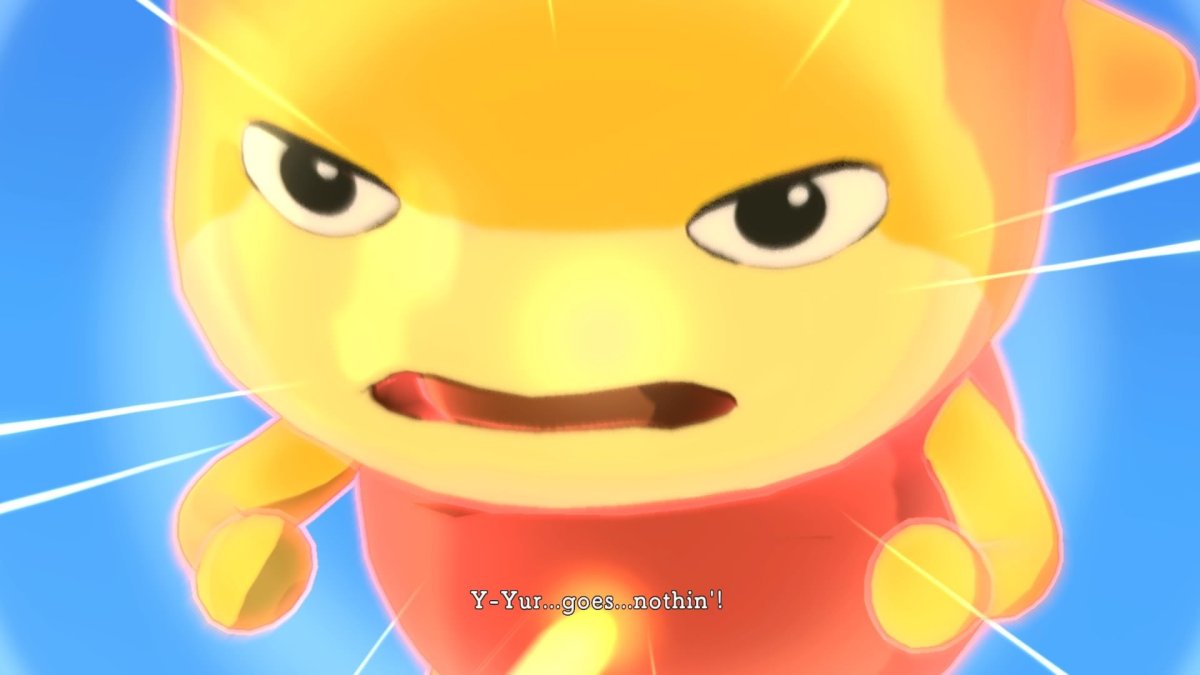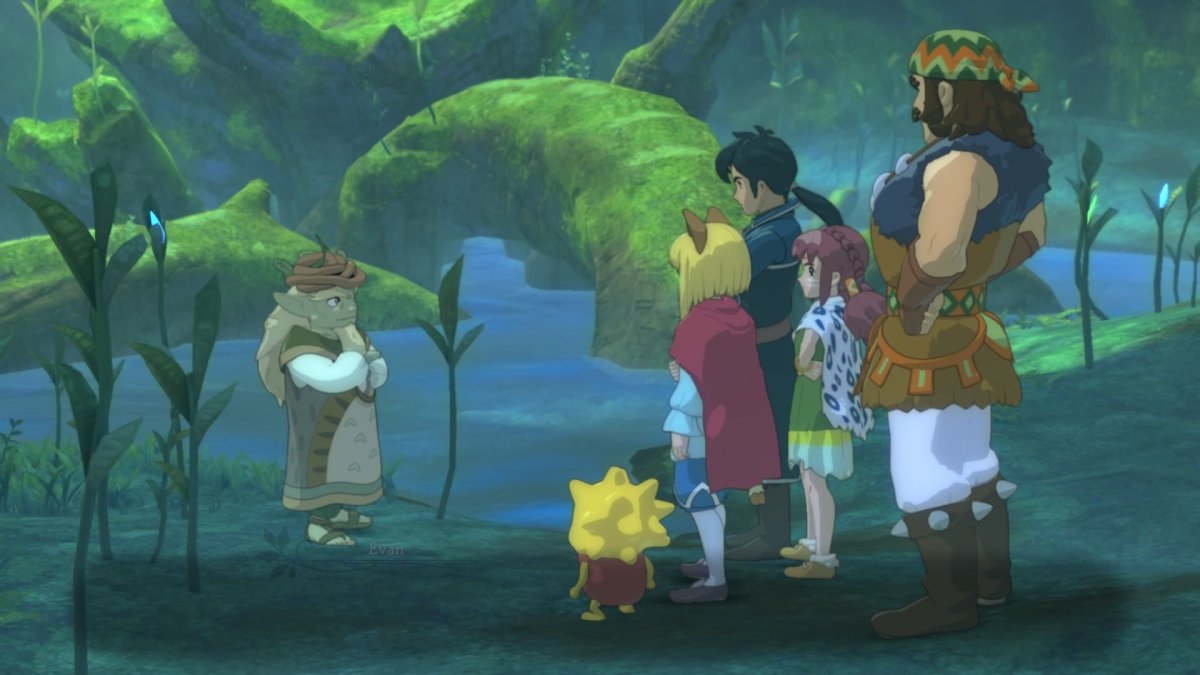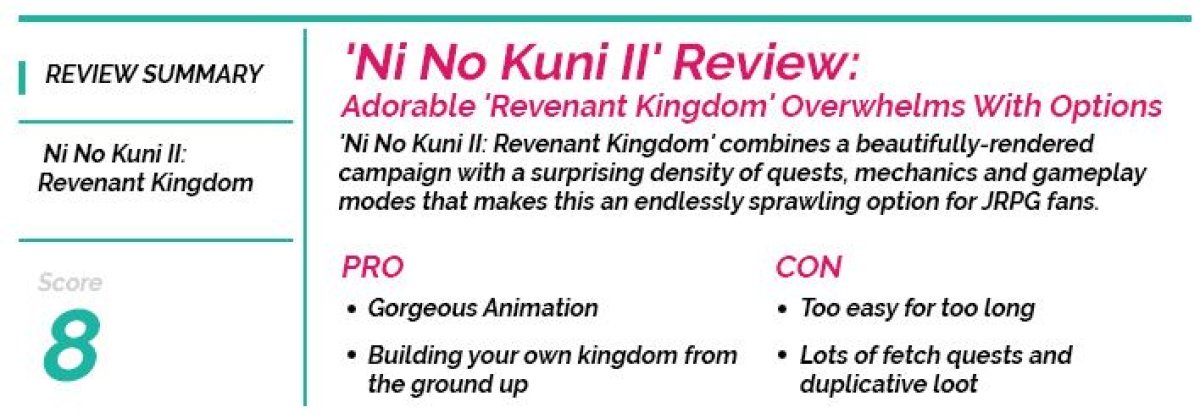Ni No Kuni II: Revenant Kingdom accumulates so many adorable details that it takes hours before the game's overwhelming scope comes into focus. There's the breathtaking animation, of course (not officially Studio Ghibli this time, but featuring character designs by Yoshiyuki Momose, who worked on Porco Rosso and Spirited Away), but also the way characters exclaim during text conversations, letting out "Golly!" and "Flip man!" or gasping at the audacity of an incidental character asking for yet another huge favor from King Evan Pettiwhisker Tildrum. There's a lot of character in Ni No Kuni II: Revenant Kingdom, including the series' strange and endearing penchant for over-the-top European accents, but more surprising is the expansiveness of its vision. Ni No Kuni 2 looks handcrafted, but boggles with the scale of its open-world gameplay.
In Ni No Kuni II: Revenant Kingdom King Evan, recently deposed in a coup, must start his own kingdom and unite all the nations of the world in peace with the help of Roland, a man from another dimension. It's a tall order, but Evan is a determined little cat boy. After Evan and Roland escape Ding Dong Dell, taken over by the mouse who poisoned the previous king, Evan's father, they seek out a land of their own. But that's only half the equation: royalty in the world of Ni No Kuni must also forge a bond with a giant protector, a kingmaker, who becomes the symbol of their house, living proof of their virtue and the ultimate weapon in their military arsenal. Where other kingdoms have Godzilla-scaled mythic beasts (one looks like the kraken from Clash of the Titans), Evan has this thing:

Unlike Ni No Kuni: Wrath of the White Witch, with its "soulmates" transposed across dimensions, Revenant Kingdom is larger in scale and a little more practical in its narrative. Visiting each of the world's kingdoms, Evan solves their problems, purifies the hearts of their leaders and brings them into his world-binding coalition. At its most zoomed out, the story of Revenant Kingdom is a straightforward one, but where it really thrives is in its episodic stories. Each new kingdom Evan visits is a radically different society, like Goldspaw, where every level of city administration runs on the luck of dice rolls, or Evan's home Ding Dong Dell, riven by cat vs. mouse tensions. At its best, a campaign chapter in Revenant Kingdom is like a good short story, with little emotional investment, but a narrative cleverness and wit.
When not exploring the world or resolving the internal political squabbles of a rival kingdom, Ni No Kuni 2 sets you to work building out your own homeland. It's not exactly Fallout 4, more a long roster of buildings to buy than a construction set, but kingdom building in Ni No Kuni is compelling because of the astonishing breadth of items, weapon, spell and armor customizations it makes available and the nation-building satisfaction of convincing people from around the world to move to your little kingdom. Ni No Kuni 2 is awash in jaunts to specific monsters, buy me this, visit here, talk to this person—fetch quests of familiar simplicity, but with the excellent reward of having recruited a new citizen, who you can assign a job and visit for a chit-chat next time you're back from an adventure and watching the throne. There's a lot in Ni No Kuni 2 that can feel unnecessarily complicated, but checking in with your kingdom—maybe upgrading a few buildings, finding places for new citizens and setting a few research projects in motion—is always a relaxing way to get off the battlefield for a few minutes.

Because a lot of Ni No Kuni 2 is spent fighting.
Early on, Ni No Kuni 2's radically different combat system is both too complicated and too simple. The basics aren't too overwhelming: there's melee, ranged and magical attacks. But complexities accumulate quickly. Higgledies —little, elemental sprites that swarm around the battlefield—can be snuffed out to charge up magic attacks. Three weapons can be swapped between each other to maximize Zing (an attack power buff that interacts with spells too). Ranged attacks can charge too. Nothing is that complicated individually, but the stack of minor mechanics makes the battlefield a chaotic place. And so it's easy to fall back on melee, the wealth of options creating the contradictory incentive to spam the strong attack button instead of exploring other tactical approaches.

While it's often easier to button mash through a fight in the early game, Ni No Kuni 2's combat grows into itself. As enemies grow beefier and more numerous, other tactics than wearing out the melee becomes more viable. Ni No Kuni 2 combat shines especially in boss fights, where you can try out a lot of different tactics and find new and different play grooves, experimenting against the long HP bars. By later chapters in the campaign, there are limitless options for players seeking out their own challenge, including grinding fields with high-level targets, "tainted" monsters that act almost like an infinite supply of boss encounters, timed dungeons, caverns and dragons on every hilltop. Combat in Revenant Kingdom rarely blew me away—the game is too easy for too long—but it was always engaging and grew more interesting instead of less.
And all that's before you start fiddling with the Tactic Tweaker. While there's traditional leveling in Revenant Kingdom, it all happens automatically. The only experience "currency" players can allocate are the Battle Points applied to the Tactic Tweaker. It looks a little like a soundboard and features all sorts of little sliders to adjust, including combat bonuses against specific enemy classes, changes to dropped loot and sliders to affect defense against a wide-range of status effects. Once enemies get tough enough, it's easy to get into the habit of slipping into the Tactics Tweaker menu to customize against the next enemy in your sights. Some people are going to go nuts for this thing, but it's also possible to mostly leave the Tweaker alone.

There's also a whole different, small-unit, real-time tactics combat system in Ni No Kuni 2, called Skirmishes, with its own arcane rule set. This is encountered infrequently during the main campaign, but can be explored more fully in side quests or just by encountering campaign flags in the field. Skirmish gameplay is loose, a little too loose, with a vaguely RTS approach that winds up feeling more like bashing hordes together than steering careful formations.
All this means that, in addition to your party members, you're also assembling literal armies from flashcards of battlefield commanders and their fighting units, plus bubbling up or discovering new Higgledies to support you in combat with optional attacks. And even after the campaign (which took about 35 hours of driven playtime), the number of side quests, unseen battlefields and more powerful monsters feels endless. Revenant Kingdom is combat-focused, but every other aspect of the game is similarly overwhelming. Spells, armor, weapons and Higgledies can be built, modified and leveled (though Higgledies are more passive and less in need of management than the familiars of Ni No Kuni: Wrath of the White Witch).
These great piles of stuff, the infinite minor variations of food, weapons, raw materials and shoes, plus the heaps of mechanics, combat modes and kingdom-building minutiae, ends up sitting a bit awkwardly with Ni No Kuni 2's more whimsical qualities. It's like a teddy bear that bristles with internal clockwork when you go in for the hug. The abundance of things to do can also stretch the specificity of Revenant Kingdom's artistic vision. It's a little disappointing to find minor variations on the same armored hamsters, wrathful fairies and requisite slime blobs pop up on every continent.
But once Revenant Kingdom has dragged you through pages of tutorials, instructions and new control schemes, it begins to settle into a disarming and satisfying groove. What you don't care for—Skirmishes in my case—begins to fall away. Instead, as your freedom and mobility increases, the vastness of the open-world allows for players to chase their own challenges. I've taken to hunting down tainted monsters in far-flung locations, but it'd be just as easy to get into the search for new citizens or the perfection of recipes. Ni No Kuni II: Revenant Kingdom's two pillars are exquisitely produced campaign moments and vast quantities of satisfying grind.

Uncommon Knowledge
Newsweek is committed to challenging conventional wisdom and finding connections in the search for common ground.
Newsweek is committed to challenging conventional wisdom and finding connections in the search for common ground.
About the writer
To read how Newsweek uses AI as a newsroom tool, Click here.








